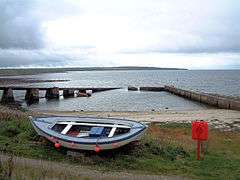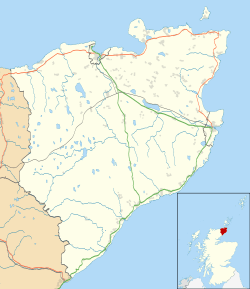Huna, Caithness
Huna is a small remote crofting township, located 1 mile northeast of Canisbay and 1.5 miles west of John o' Groats in Caithness, in Scotland.[1] It is currently part of the Highland Council area.
| Huna | |
|---|---|
 Huna harbour | |
 Huna Location within the Caithness area | |
| Population | 139 |
| OS grid reference | ND369732 |
| Council area | |
| Lieutenancy area | |
| Country | Scotland |
| Sovereign state | United Kingdom |
| Post town | WICK |
| Postcode district | KW1 4YL |
| Dialling code | 01955 |
| Police | Scotland |
| Fire | Scottish |
| Ambulance | Scottish |
| UK Parliament | |
| Scottish Parliament | |
History
Huna is likely to have been an important sheltered port from Norse times and it has been suggested that it equates to Hofn, the burial place in 980 of Hlodvar Thorfinnsson, the Norse Jarl of Orkney. In The Place-Names of Canisbay, Caithness, Huna is described as:
- A crofting township two miles west from John o' Groat's, situated at the foot of the Mool Hill. Bordered on the west side by the burn of Huna, and on the east side by the Ness of Huna, a small crest–like peninsula which terminates in a beach. On Huna links are the remains of a Picts' village and several burial cairns. It is supposed to be the burial place of earl Hlǫðver, who, the saga states, was buried at Hǫfn in Katanes, about 975. The haven of Huna is a sandy beach. O.N. hǫfn > ham in Orkney and Shetland, and there is a Ham in Dunnet adjoining an earth-house. Myrkkol, now Murkle, where Hlǫðver’s brother, earl Arnfinnr, lived, is much nearer Ham than Huna. In Caithness charter, 1574, Hwnaye; 1777 Houna. Cf. Huney in Shetland, O.N. Húna-ey, the island of a man Húni. O.N. *Húna-á, the burn of Húni. Cosmo Innes in Orig. Par. Scot. suggested, "Huna appears to be the Hofn where earl Hlodver was buried" — a suggestion which apparently arose from an impossible derivation.[2]
John o' Groat (Jan de Grot) ran a ferry from Huna to Orkney c. 1500 and a mail service between Huna and South Ronaldsay began in 1819.
Archaeology
The following sites are recorded on Highland Council’s Historic Environment Record (HER)
- MHG 1735 and MHG 39848 Site of Norse building and midden at ND 3592 7357 Drystone walling and midden material within a sand mound
- MHG 2525 Mound, boat burial at ND 3599 7363 Recorded by Curle in 1935 as eroding out of the sand at the top of the bank, and containing wood, rivets, chain and metal objects.
- MHG 1742 Mound, boat burial at ND 3610 7360. Probably an incorrect location and confused with the above site, now overlaid by recent building work and landscaping (1982)
- MHG 1743 Mound, Norse walling at ND 3603 7365. Mound measuring 15m by 9.8m with exposed walling, but now obscured by modern rubbish dumping (1982)
- MHG 1739 Banked enclosure at ND 3623 7352. Cropmark measuring 25m in diameter but no visible evidence on the ground
The first four of these sites occupy the crest of the rise from the shoreline to the west of Huna House, while the last is in the field to the NE of the field in which the present development is located.
Property Ownership
Over the last 2000 years Huna has been owned as a part of the greater area of Caithness under wider ownership such as the Pictish Kingdoms and later the Estates of Mey. The possibility of individual ownership of land and property within Huna and nearby townships didn't occur until 1952 when the estates of Mey were broken up and sold by Captain Fredrick Bouhier Imbert-Terry, including the sale of individual crofts within Huna.
| Approximate Dates | Owners | Notes |
|---|---|---|
| 25 - 871 AD | Kingdom of Cat (Cait), Pictish Kingdom | Kingdom Waned from 697AD After the death of King Taran mac Entifidich |
| 871 AD - Unknown | Wider Pictish Kingdom | |
| Unknown | Norse Kingdoms | possible burial place in 980AD of Hlodvar Thorfinnsson the Norse Earl of Orkney |
| Unknown | Earls of Orkney (Norway) | Caithness Disputed as part of Norway and Scotland |
| Unknown | Bishops of Caithness | As part of the Bishoprics of King David 1st |
| 1334 - 1335 | Earls of Caithness (1st Creation) | Forfeited to the Crown |
| 1335 - 1375 | Scottish Crown | |
| 1375 - 1437 | Earls of Caithness (2nd Creation) | Awarded to Son of Robert II of Scotland later Forfeited by 3rd Earl |
| 1437 - 1452 | Scottish Crown | |
| 1452 - August 1454 | George Crichton Earls of Caithness (3rd Creation) | Passed to Crown by Agreement upon death [3] |
| August 1454 - 1455 | Scottish Crown | |
| 1455 - 1889 | 1st - 15th Earls of Caithness (4th Creation) | Grant unto William Sinclair, 1st Earl of Caithness Builder of Rosslyn Chapel |
| 1889 | Mr F.G. Heathcote (Sinclair) | Estate of Mey Bequeathed by 15th Earl of Caithness |
| Unknown | Captain Fredrick Bouhier Imbert-Terry | Purchased the Estates of Mey from the widow of Mr F.G Heathcote (Sinclair) |
| 1952 | Individual Ownership | Mey Estate broken up and sold including Castle of Mey and Crofts of Huna |
Sources
- "Huna". The Gazetteer for Scotland. School of GeoSciences, University of Edinburgh and The Royal Scottish Geographical Society. Retrieved 4 July 2018.
- Mowat, John (1931). The Place-Names of Canisbay, Caithness: With Map (PDF). p. 27. Retrieved 4 April 2020.
- "Archived copy". Archived from the original on 16 July 2011. Retrieved 14 June 2009.CS1 maint: archived copy as title (link) 1
External links

- Official website
| Wikimedia Commons has media related to Huna, Caithness. |